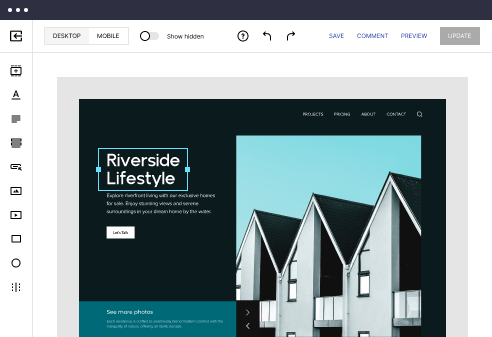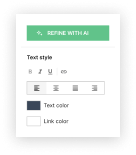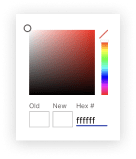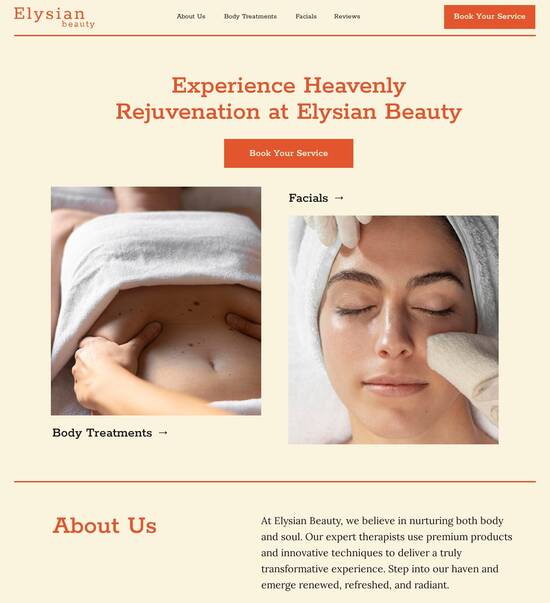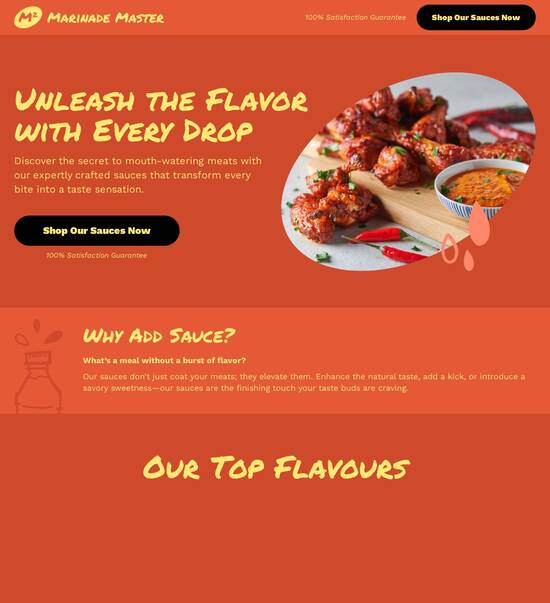
Next.js optimized checkout page template
Explore Similar TemplatesAbout template
Supercharge your checkout page with Next.js for outstanding performance! Learn more today.
Recommended templates
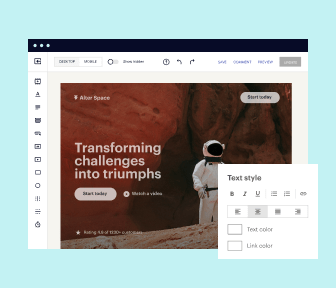
Easy to build without coding
With the intuitive drag-and-drop builder, anyone on your team can create high-converting pages without any knowledge of code or design. Make enhancements to your landing page with custom widgets using Javascript, HTML/CSS, or third-party scripts.
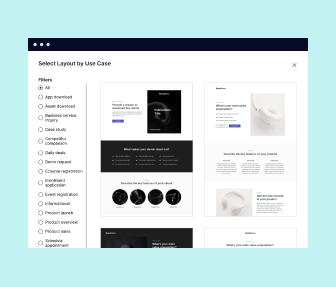
Multiple layouts for any industry and goal
Select from 500+ landing page layouts built to boost conversions across industry-specific scenarios. Customize them by adjusting fonts, adding images, and generating on-brand content with the AI assistant. Quickly scale with Instablocks® and Global Blocks that you can save, reuse, and update globally.
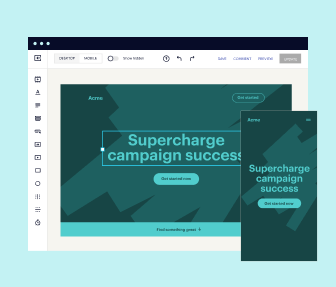
Loads fast and looks polished on any device
Every template is responsive, which means they present professionally on any device and load blazingly fast with our Thor Render Engine. You can also power them up with Google AMP technology to deliver an unparalleled mobile experience and drive higher conversions.
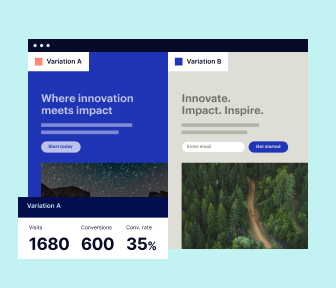
Robust analytics & experimentation
Get real-time updates and reporting across all your devices, showing the number of visitors, conversions, cost-per-visitor, and cost-per-lead. Launch AI-powered experiments, run A/B tests, and use heatmaps to analyze user behavior, then optimize your landing page to maximize conversions.
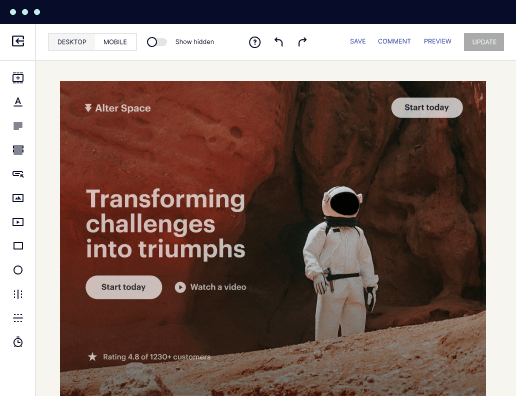
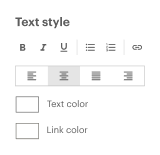
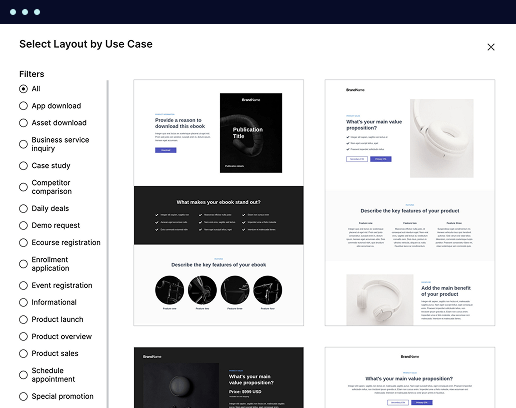
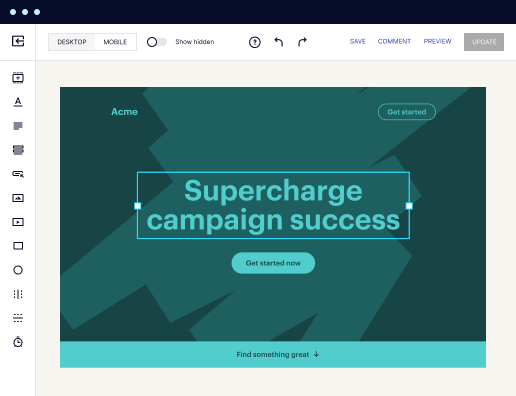
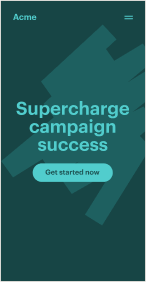
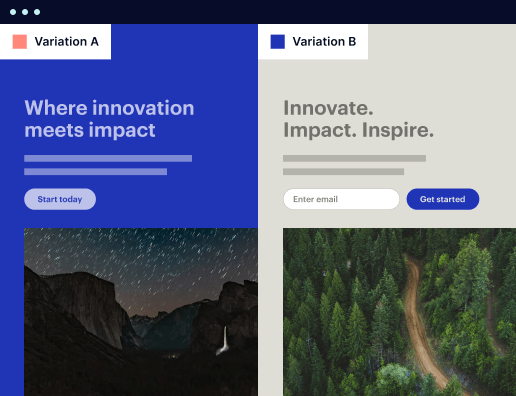
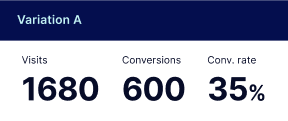
Easy to build without coding
With the intuitive drag-and-drop builder, anyone on your team can create high-converting pages without any knowledge of code or design. Make enhancements to your landing page with custom widgets using Javascript, HTML/CSS, or third-party scripts.
Multiple layouts for any industry and goal
Select from 500+ landing page layouts built to boost conversions across industry-specific scenarios. Customize them by adjusting fonts, adding images, and generating on-brand content with the AI assistant. Quickly scale with Instablocks® and Global Blocks that you can save, reuse, and update globally.
Loads fast and looks polished on any device
Every template is responsive, which means they present professionally on any device and load blazingly fast with our Thor Render Engine.
Robust analytics & experimentation
Get real-time updates and reporting across all your devices, showing the number of visitors, conversions, cost-per-visitor, and cost-per-lead. Launch AI-powered experiments, run A/B tests, and use heatmaps to analyze user behavior, then optimize your landing page to maximize conversions.
All the features you need to build nextjs multiple layouts
Explore more featuresLearn how to build template checkout page nextjs
FAQs
Leading the way in building high-performing landing pages





Create high-converting landing pages with Instapage
In the world of digital marketing, effective landing pages are essential for maximizing the ROI of your campaigns. With Instapage's all-in-one landing page and CRO platform, marketers can accelerate their campaign efforts using high-quality templates and personalization tools designed to drive higher conversions.
Why choose Instapage for your landing pages?
Instapage distinguishes itself from other platforms with its powerful features tailored for marketers across various industries, including tech, financial services, and education. It allows users to build optimized landing pages quickly, ensuring that every campaign reaches its full potential.
- 100+ high-converting templates: Customized templates save time and provide the structure you need to create compelling landing pages without starting from scratch.
- Built-in A/B testing functionality: Optimize your pages by testing variations to understand what works best for your audience.
- Comprehensive analytics dashboard: Gain insights into user behavior and engagement to fine-tune your landing pages for maximum effectiveness.
Steps to creating your first landing page
Creating a high-performing landing page with Instapage is straightforward. Follow these steps to guide your design process.
Step 1: Choose a template
Start your journey by selecting a template that resonates with your campaign goals. Here’s what to consider in your selection:
- Align template design with brand identity: Ensure your template reflects your brand's colors and styles.
- Focus on call-to-action (CTA): Templates designed with strong CTAs have proven to be more effective.
- Consider your audience’s needs: Tailor your choice based on the demographics and behaviors of your target market.
Step 2: Customize for personalization
Personalization can significantly impact conversion rates. Use Instapage’s dynamic text replacement feature to align messaging with specific audience profiles.
- Utilize data-driven insights: Craft customized messages that resonate with different audience segments for better engagement.
- Employ AdMaps: Connect your targeted ads directly to tailored landing pages, enhancing relevance.
- Test variations: Experiment with different personalized content to identify what resonates most with each audience segment.
By following these steps, you can create an optimized landing page that drives conversions and supports your business aims.
Start using Instapage today and transform your landing pages into powerful conversion tools. Sign up now to discover the full range of features available!
Next.js optimized checkout page template: A comprehensive guide
Understanding the Next.js framework and its role in modern e-commerce
Next.js is a powerful React framework designed to enhance the capabilities of traditional web applications, making it an excellent choice for the evolving needs of e-commerce. With its focus on performance, scalability, and developer experience, Next.js streamlines the process of building high-quality web applications. It allows developers to create static, dynamic, or hybrid sites, maximizing loading efficiency and providing tailored experiences for users.
Server-side rendering (SSR): This feature speeds up the initial page load by rendering the page on the server rather than the client, which improves user experience.
Static site generation (SSG): Enables developers to pre-render pages at build time, resulting in faster performance and better search engine optimization (SEO).
API routes for backend integration: Allows for seamless routing of API requests, making it easy to connect to databases and third-party services.
Unpacking the optimized checkout page template
An optimized checkout page template in Next.js is meticulously designed to enhance the purchasing process for users, ensuring a smooth and efficient experience. Key characteristics of such a template include speed, responsive design, and a streamlined user interface, all crucial for reducing friction during checkout. These templates are built with best practices to ensure they not only look good but also perform exceedingly well.
A standout feature of an optimized checkout page template is its capability to minimize load times while securely processing transactions. Additionally, it often integrates easily with various payment gateways, simplifying the setup for developers while enhancing user trust through visible security measures.
Key features to look for
When evaluating a Next.js optimized checkout page template, users should prioritize performance, user experience, and security. High-performance templates leverage advanced coding techniques to ensure quick loading times, which are essential for keeping potential customers engaged.
Performance optimization: Fast loading times create an immediate positive impression, and using dynamic imports helps minimize the bundle size, allowing essential resources to load first.
User experience (UX) enhancements: An intuitive design ensures easy navigation through the checkout flow, ideally complemented by mobile-first design principles to cater to users on various devices.
Security measures: Secure protocols for handling user data and ensuring PCI compliance make shopping safer, fostering trust between customers and the e-commerce platform.
Benefits of using Next.js for your checkout page
Implementing an optimized checkout process using Next.js can vastly improve e-commerce conversions. Research shows that a seamless checkout experience can significantly reduce cart abandonment rates. When users can complete their purchases effortlessly, they're more likely to finish their transactions, leading to higher overall sales volume for businesses.
A/B testing can be implemented easily with Next.js templates, allowing businesses to test various layouts, button placements, and text to identify the most effective designs. An iterative approach ensures continuous improvements based on real user data, ultimately contributing to a more effective e-commerce strategy.
Seamless integration with multipurpose SaaS themes
Many multipurpose SaaS themes are designed with compatibility in mind, ensuring that your Next.js checkout page fits seamlessly within your overall site structure. These themes often come with layout options and components that enhance the checkout experience.
Ease of customization: Features like customizable buttons, typography, and colors help businesses align the checkout page with their branding.
Pre-built components: Many themes offer a library of pre-designed components that speed up the development process while maintaining aesthetic quality.
Integration with analytics tools: Features supporting analytics enable businesses to track user behavior through the checkout process, aiding in further optimization.
The development process: Building an optimized checkout page
The development of an optimized checkout page involves selecting the right template and ensuring it aligns with existing tech stacks. Compatibility is important, and developers should also consider the flexibility for customizations. A well-suited template allows for adjustments that meet unique business needs while ensuring an overall fluid user experience.
Look for templates with easy-to-navigate structures that support modifications and integrations.
Evaluate popular templates within the Next.js community to find motivating examples of effective designs and functionalities.
Ensure that the template supports responsive design for optimal performance across various devices.
Integrating with payment gateways
Integrating payment gateways is a critical aspect of building an efficient checkout page. Two of the most popular gateways, Stripe and PayPal, offer developer-friendly APIs that simplify the integration process. Developers should follow clear steps to integrate these solutions securely while ensuring that the user experience remains intact.
The integration process typically involves setting up an account with the payment provider, using their SDK to implement payment features, and testing transactions thoroughly. Prioritizing user experience during transactions can involve minimizing the number of redirects, providing visible feedback, and offering multiple payment options.
User authentication and account management
Secure user authentication is essential in today's digital marketplace. Providing various authentication options, such as email, social logins, and two-factor authentication, enhances user convenience while prioritizing security. Implementing these options encourages users to create accounts, making account management smoother.
After authentication, a robust account management system allows users to view their order history and update personal information easily. This adds another layer of user experience, as customers appreciate knowing they have control over their data and can easily manage their purchases.
Customizing your template: Enhancing functionality and aesthetics
Customizing templates in Next.js allows for heightened functionality and enriched aesthetics tailored to business requirements. Developers can utilize JavaScript for creating personalized user experiences that adapt to individual needs. Styling options expand with CSS-in-JS libraries, offering extensive control over design elements.
By leveraging these tools, businesses can create visually appealing and user-centric checkout processes that encourage transactions and reduce drop-off rates, ensuring optimal customer satisfaction.
Internationalization and RTL support
With the global rise of e-commerce, adapting checkout pages for a worldwide audience is imperative. Internationalization (i18n) enables businesses to customize content based on geographic and linguistic demographics, facilitating easier access for users in various regions. This means incorporating localization features within the Next.js template to dynamically adjust language, currency, and regulatory requirements.
Moreover, supporting Right-To-Left (RTL) languages is crucial for markets that utilize scripts in this format. Ensuring your template is flexible enough to provide these adaptations can broaden your customer base and deliver an inclusive shopping experience.
Documentation and resources for developers
Navigating Next.js documentation is essential for developers seeking to build optimized checkout pages. Comprehensive documentation can significantly streamline the development process, offering insights into advanced features, API references, and suggested best practices. Leveraging these resources not only assists in addressing challenges but also supports continuous improvement of e-commerce applications.
Next.js official documentation: A wealth of information covering everything from setup to advanced configurations.
Community tutorials: Platforms like YouTube and specialized blogs provide practical insights and step-by-step guides.
Template marketplaces: Sites that specialize in Next.js templates offer pre-built options that developers can adapt.
Community and support channels
Engagement with development communities is vital for those working with Next.js. Online forums, discussions on platforms such as Reddit, and dedicated chat platforms like Discord facilitate knowledge sharing. Developers can ask questions, share experiences, and offer support, fostering a collaborative community dedicated to the advancement of Next.js.
Additionally, GitHub repositories allow developers to inspect code, identify bugs, and contribute to solutions ranging from template enhancements to library improvements. Being active in these channels ensures developers stay informed about the latest trends and best practices in Next.js development.
Real-world applications and case studies
Many brands have successfully adopted Next.js for their checkout functionalities, leading to remarkable improvements in sales and user engagement. Case studies reveal that incorporating an optimized checkout page has lowered cart abandonment rates and enhanced customer loyalty. By analyzing these outcomes, other businesses can adapt successful strategies.
E-commerce giants utilizing Next.js have reported a 20% decrease in cart abandonment.
Smaller businesses have experienced increased conversion rates after streamlined checkout processes.
Sector-wide improvements observed in SEO performance due to optimized loading speeds.
Comparative analysis with other frameworks
When comparing Next.js with frameworks like React and Vue, it becomes evident that Next.js offers specific advantages when focusing on e-commerce checkout pages. For instance, its efficient server-side rendering provides better initial load speeds than typical React applications. While React is versatile, it often requires additional setup for SSR, which can be a drawback for teams wanting speed.
Additionally, Vue also excels in performance but may not provide the same level of community support and documentation as Next.js. Ultimately, the choice of framework should align with the specific needs and capabilities of the development team while considering long-term goals for the e-commerce platform.
Future trends and innovations in checkout page development
As e-commerce continues to evolve, anticipating future developments in technology is crucial. Emerging trends suggest an increased emphasis on personalization, machine learning, and AI-driven insights to enhance the customer journey. Businesses may look to integrate intelligent features that adapt based on user behavior, optimizing product suggestions and checkout processes.
Voice-activated checkout assistants may become common, enhancing user interactions.
Augmented reality (AR) features will likely offer a more engaging shopping experience.
Blockchain technology may enhance transaction security, providing new levels of trust for users.
The evolution of user expectations
User expectations have advanced over recent years, shaping the demand for optimized checkout processes. Today’s consumers anticipate swift transactions, intuitive interfaces, and unparalleled security. Businesses that respond to these evolving needs can differentiate themselves in a crowded market.
As e-commerce continues to adapt to changing consumer behavior, remaining proactive in optimizing checkout templates is paramount. This adaptability ensures businesses remain competitive and relevant in an ever-evolving landscape.
Ready to skyrocket conversions?
Supercharge your ad campaigns with high-performing landing pages
Get started